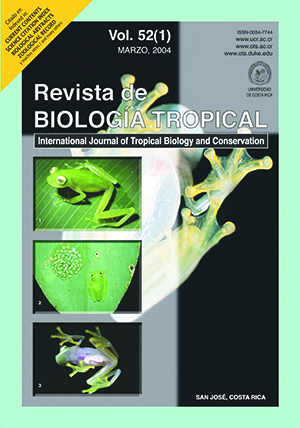Abstract
The euglenoids are unicellular eukaryotic flagellates living in a diversity of soils and aquatic environments and ecosystems. This study describes the ultrastructure of an euglenoid isolated from the surface of a boiling mud pool with temperatures ranging from 38 to 98°C and pH 2 - 4. The hot mud pool is located in Area de Pailas de Barro, Las Pailas, Rincón de la Vieja Volcano, Guanacaste, Costa Rica. The morphological characterization of the Euglena pailasensis was performed by SEM and TEM. It was determined that, although the euglenoid was obtained from an extreme volcanic environment, the general morphology corresponds to that of a typical member of Euglena of 30-45 μm long and 8-10 μm wide, with membrane, pellicle, chloroplasts, mitochondria, nucleus, pigments and other cytoplasmic organelles. E. pailasensis is delimited by a membrane and by 40 to 90 pellicle strips. It was observed up to 5 elongated chloroplasts per cell. The chloroplast contains several osmiophilic globules and a pyrenoid penetrated by few thylakoid pairs. The nutritious material is reserved in numerous small paramylon grains located at the center of the cell, mitocondria are characterized by the presence of crests in radial disposition toward the interior of the lumen. It was also observed around the external surface “pili” like filaments originating from the pellicle strips. There is no evidence for the presence of flagella in the ampulla (reservoir/canal area), a fact confirmed by negative staining, and a difference regarding other species of Euglena. The observed ultrastructural characteristics are not sufficient to explain the adaptation of this species to acid and hot environmentsReferences
Adachi, E. 1999. Gallium replication in aquatic and nonaquatic organism scanning electron microscopy. Ultramicroscopy 80: 51-58.
Arnott, H.J. & M.A. Farmer. 2000. Comparative morphology of the euglenid oellicle. I. Patterns of strips and pores. J. Eukaryot. Microbiol. 47: 469-479.
Brock, T.D. 1986. Introducction: An overview of the thermophiles. pp. 1-16. In: Brock T. D.(eds). Termophiles, general, molecular and applied microbiology. John Wiley & Sons, New York.
Dubreuil, R.R. & G.B. Bouck. 1985. The membrane skeleton of a unicellular organism consists of bridged, articulating strips. J. Cell. Biol. 101: 1884-1896.
Kapfer, M. 1998. Assessment of the colonization and primary production of microphytobenthos in the littoral of acidic mining lakes in Lusatia (Germany). Wat. Air Soil Pollut. 108: 331-340.
Kempner, E.S. & A.G. Marr. 1970. Growth in volume of Euglena gracilis during the division cycle. J. Bacteriol.101: 561-567.
Leedale, G.F. 1964. Pellicle structure in Euglena . Brit. Phycol. Bull 2: 291-306.
Leedale, G.F., J.D. Meeuse & E.G. Pringsheim. 1965. Structure and physiology of Euglena spirogyra. I and II. Arch. für Mikrobiol. 50: 68-102.
Leedale, G.F. 1967. Euglenoid Flagellates. Prentice-Hall. Inc. Englewoud Clifs, N.J. U.S.A. p. 137-192.
Lefort-Tran, M., M.H. Bre, J.L. Ranck & M. Pouphile. 1980. Euglena plasma membrane during normal and vitamin B12 starvation growth. J. Cell. Sci. 41: 245- 261.
Lessman, D., R. Deneke, R. Ender, M. Hemm, M. Kapfer, H. Krumbeck, K. Wollmamm & B. Nixdorf. 1999. Lake Plessa 107 (Lusatia, Germany) - an extremely acidic shallow mining lake. Hidrobiol. 408/409: 293- 299.
Lowy, J. & J. Hanson. 1965. Electron microscope studies of bacterial flagella. J. Mol. Biol. 11: 293-313.
Mermelstein, C.S., A. P. Rodríguez, M. Einicker-Lamas, R.E. de B. Navarrete, M. Farina & M.L. Costa. 1998. Distribution of F-actin, a-actinin, tropomyosin, tubulin and organelles in Euglena gracilis by inmunofluorescence microscopy. Tissue & Cell 30: 545-553.
Müllner A. N., D. G. Angeler, R. Samuel, E. W. Linton & R. E. Triemer. 2001. Phylogenetic analysis of phagotropic, phototrophic and osmotrophic euglenoids by using the nuclear 18 sDNA sequence. Int. J. Syst. Evol. Microb. 51: 783-791.
Murray, J.M. 1981. Control of cell shape by calciumin the Euglenophyceae. J. Cell. Sci. 49: 99-117.
Osafune, T., S. Sumida, E., T. Ehara, N. Ueno, E. Hase & J.A. Schiff. 1990. Lipid (wax) and paramylum as sources of carbon and energy for the early development of proplastidas in dark-grown Euglena gracilis cells transferred to an inorganic medium. J. Electron. Microsc. 39: 372-381.
Pringsheim, E.G. 1948. Taxonomic problems in the Euglenineae. Biol. Rev. 23: 46-61.
Pringsheim, E.G. 1956. Contribution towards a monograph of the genus Euglena. Nova Acta Leopoldina 18: 1- 168.
Schwartzbach, S.D., J.A. Schiff & N. Goldstein. 1975. Events surrounding the early development of Euglena chloroplasts. Control of paramylum degradation. Plant Physiol. 56: 313-317.
Sittenfeld, A., M. Mora, J.M. Ortega, F. Albertazzi, A. Cordero, M. Roncel, E. Sánchez, M. Vargas, M.
Fernández, J. Weckesser & A. Serrano. 2002. Characterization of a photosynthetic Euglena strain isolated from an acidic hot mud pool of a volcanic area of Costa Rica. FEMS Microbiol. Ecol. 42: 151-161.
Sittenfeld, A., M. Vargas, E. Sánchez, M. Mora & A. Serrano. 2004. Una nueva especie de Euglena (Euglenozoa: Euglenales) aislada de ambientes extremófilos en las Pailas de Barro del Volcán Rincón de la Vieja, Costa Rica. Rev. Biol. Trop. 52: 27-30.
Sueoka, N., K.S. Chiang & J.R. Kates. 1967. Deoxiribonucleic acid and replication in meiosis of Chlamydomonas reinhardtii. Isotipic transfer experiments with a strain producing eight zoospores. J. Mol. Biol. 25: 47-66.
Summer, J.R. 1965. The ultrastructure of the pellicle complex of Euglena gracilis. J. Cell. Biol. 24: 253 257.
Van den Hoek, C., D.G. Mann & H.M. Jahns. 1993. Algae: An introduction to phycology. Cambridge University, Cambridge. 627 p.
Vismara R., L. Barsanti, P. Lupetti, V. Passarelli, D. Mercati, F. Dallai & P. Gualtieri. 2000. Ultrastructure of the pellicle of Euglena gracilis. Tissue & Cell 32: 451-456.
Walsh M. M. & J. Seckbach. 1999. The versatility of microorganisms. p. 153-162. In: Seckbach (eds.). Microorganisms and life in extreme environments. J. Kluver Academic Publishers, Netherlands.
Wen J. 2000. The nuclear matrix of Euglena gracilis (Euglenophyta): A stage of nuclear matrix evolution?
Biol. Cell. 92: 125-131.
Zakrys B., J. Cambra-Sanchez & P.L. Walne. 2001. Chloroplast ultrastructure of Euglena cuneata Pringsheim, E. deses Ehrenberg and E. mutabilis (Euglenophyceae): Taxonomic significance. Acta Protozool. 40: 161-167.
##plugins.facebook.comentarios##

This work is licensed under a Creative Commons Attribution 4.0 International License.
Copyright (c) 2004 Revista de Biología Tropical


